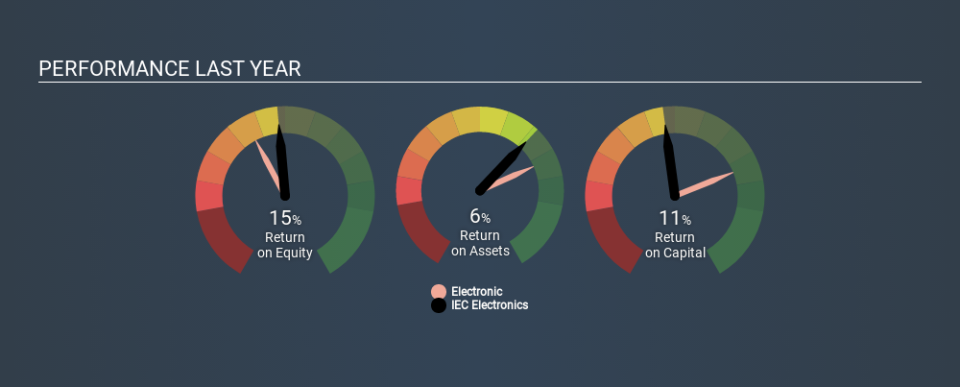Does IEC Electronics Corp. (NASDAQ:IEC) Create Value For Shareholders?

Today we'll evaluate IEC Electronics Corp. (NASDAQ:IEC) to determine whether it could have potential as an investment idea. Specifically, we're going to calculate its Return On Capital Employed (ROCE), in the hopes of getting some insight into the business.
First up, we'll look at what ROCE is and how we calculate it. Second, we'll look at its ROCE compared to similar companies. Then we'll determine how its current liabilities are affecting its ROCE.
Understanding Return On Capital Employed (ROCE)
ROCE is a metric for evaluating how much pre-tax income (in percentage terms) a company earns on the capital invested in its business. In general, businesses with a higher ROCE are usually better quality. Ultimately, it is a useful but imperfect metric. Author Edwin Whiting says to be careful when comparing the ROCE of different businesses, since 'No two businesses are exactly alike.
So, How Do We Calculate ROCE?
The formula for calculating the return on capital employed is:
Return on Capital Employed = Earnings Before Interest and Tax (EBIT) ÷ (Total Assets - Current Liabilities)
Or for IEC Electronics:
0.11 = US$7.6m ÷ (US$111m - US$42m) (Based on the trailing twelve months to September 2019.)
Therefore, IEC Electronics has an ROCE of 11%.
See our latest analysis for IEC Electronics
Is IEC Electronics's ROCE Good?
When making comparisons between similar businesses, investors may find ROCE useful. We can see IEC Electronics's ROCE is around the 12% average reported by the Electronic industry. Regardless of where IEC Electronics sits next to its industry, its ROCE in absolute terms appears satisfactory, and this company could be worth a closer look.
IEC Electronics's current ROCE of 11% is lower than its ROCE in the past, which was 20%, 3 years ago. Therefore we wonder if the company is facing new headwinds. You can see in the image below how IEC Electronics's ROCE compares to its industry. Click to see more on past growth.
Remember that this metric is backwards looking - it shows what has happened in the past, and does not accurately predict the future. ROCE can be misleading for companies in cyclical industries, with returns looking impressive during the boom times, but very weak during the busts. ROCE is only a point-in-time measure. What happens in the future is pretty important for investors, so we have prepared a free report on analyst forecasts for IEC Electronics.
Do IEC Electronics's Current Liabilities Skew Its ROCE?
Current liabilities include invoices, such as supplier payments, short-term debt, or a tax bill, that need to be paid within 12 months. The ROCE equation subtracts current liabilities from capital employed, so a company with a lot of current liabilities appears to have less capital employed, and a higher ROCE than otherwise. To counter this, investors can check if a company has high current liabilities relative to total assets.
IEC Electronics has total assets of US$111m and current liabilities of US$42m. Therefore its current liabilities are equivalent to approximately 38% of its total assets. IEC Electronics has a middling amount of current liabilities, increasing its ROCE somewhat.
The Bottom Line On IEC Electronics's ROCE
IEC Electronics's ROCE does look good, but the level of current liabilities also contribute to that. There might be better investments than IEC Electronics out there, but you will have to work hard to find them . These promising businesses with rapidly growing earnings might be right up your alley.
If you are like me, then you will not want to miss this free list of growing companies that insiders are buying.
If you spot an error that warrants correction, please contact the editor at editorial-team@simplywallst.com. This article by Simply Wall St is general in nature. It does not constitute a recommendation to buy or sell any stock, and does not take account of your objectives, or your financial situation. Simply Wall St has no position in the stocks mentioned.
We aim to bring you long-term focused research analysis driven by fundamental data. Note that our analysis may not factor in the latest price-sensitive company announcements or qualitative material. Thank you for reading.

